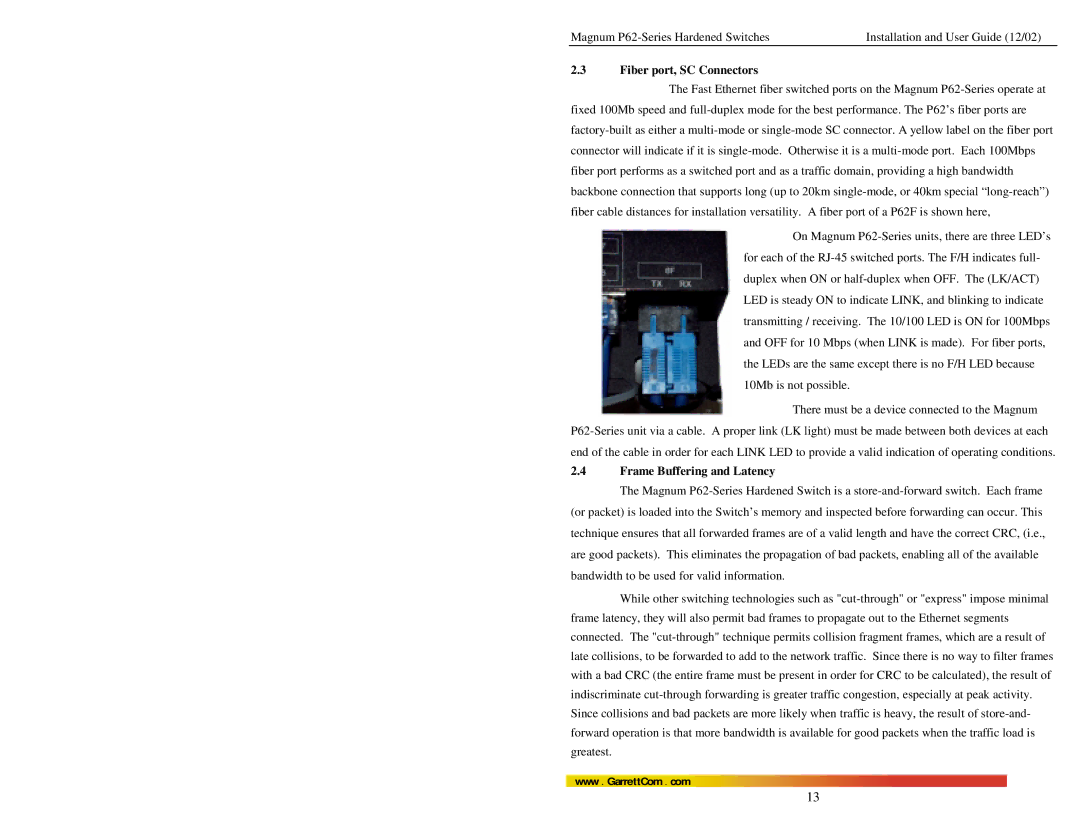Magnum P62-Series Hardened Switches | Installation and User Guide (12/02) |
2.3Fiber port, SC Connectors
The Fast Ethernet fiber switched ports on the Magnum P62-Series operate at fixed 100Mb speed and full-duplex mode for the best performance. The P62’s fiber ports are factory-built as either a multi-mode or single-mode SC connector. A yellow label on the fiber port connector will indicate if it is single-mode. Otherwise it is a multi-mode port. Each 100Mbps fiber port performs as a switched port and as a traffic domain, providing a high bandwidth backbone connection that supports long (up to 20km single-mode, or 40km special “long-reach”) fiber cable distances for installation versatility. A fiber port of a P62F is shown here,
On Magnum P62-Series units, there are three LED’s for each of the RJ-45 switched ports. The F/H indicates full- duplex when ON or half-duplex when OFF. The (LK/ACT) LED is steady ON to indicate LINK, and blinking to indicate transmitting / receiving. The 10/100 LED is ON for 100Mbps and OFF for 10 Mbps (when LINK is made). For fiber ports, the LEDs are the same except there is no F/H LED because 10Mb is not possible.
There must be a device connected to the Magnum
P62-Series unit via a cable. A proper link (LK light) must be made between both devices at each end of the cable in order for each LINK LED to provide a valid indication of operating conditions.
2.4Frame Buffering and Latency
The Magnum P62-Series Hardened Switch is a store-and-forward switch. Each frame
(or packet) is loaded into the Switch’s memory and inspected before forwarding can occur. This technique ensures that all forwarded frames are of a valid length and have the correct CRC, (i.e., are good packets). This eliminates the propagation of bad packets, enabling all of the available bandwidth to be used for valid information.
While other switching technologies such as "cut-through" or "express" impose minimal frame latency, they will also permit bad frames to propagate out to the Ethernet segments connected. The "cut-through" technique permits collision fragment frames, which are a result of late collisions, to be forwarded to add to the network traffic. Since there is no way to filter frames with a bad CRC (the entire frame must be present in order for CRC to be calculated), the result of indiscriminate cut-through forwarding is greater traffic congestion, especially at peak activity. Since collisions and bad packets are more likely when traffic is heavy, the result of store-and- forward operation is that more bandwidth is available for good packets when the traffic load is greatest.
www . GarrettCom . com

